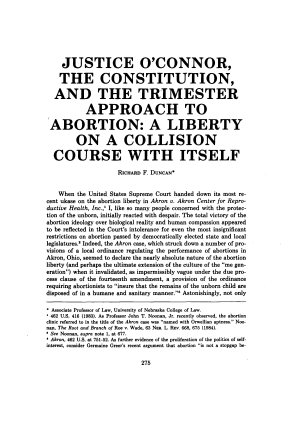Justice O'Connor, the Constitution, and the Trimester Approach to Abortion: A Liberty on a Collision Course with Itself
January 2, 1984

DISCLAIMER: This text has been transcribed automatically and may contain substantial inaccuracies due to the limitations of automatic transcription technology. This transcript is intended only to make the content of this document more easily discoverable and searchable. If you would like to quote the exact text of this document in any piece of work or research, please view the original using the link above and gather your quote directly from the source. The Sandra Day O'Connor Institute does not warrant, represent, or guarantee in any way that the text below is accurate.
Article Text
(Excerpt, Automatically generated)
JUSTICE O'CONNOR, THE CONSTITUTION, AND THE TRIMESTER APPROACH TO 'ABORTION: A LIBERTY ON A COLLISION COURSE WITH ITSELF
RICHARD F. DUNCAN*
When the United States Supreme Court handed down its most re cent ukase on the abortion liberty in Akron v. Akron Center for Repro ductive Health, Inc.,1 I, like so many people concerned with the protec tion of the unborn, initially reacted with despair. The total victory of the abortion ideology over biological reality and human compassion appeared to be reflected in the Court's intolerance for even the most insignificant restrictions on abortion passed by democratically elected state and local legislat ures.1 Indeed, the Akron case, which struck down a number of pro visions of a local ordinance regulating the performance of abortions in Akron, Ohio, seemed to declare the nearly absolute nature of the abortion liberty (and perhaps the ultimate extension of the culture of the "me gen eration") when it invalidated, as impermissibly vague under the due pro cess clause of the fourteenth amendment, a provision of the ordinance requiring abortionists to "insure that the remains of the unborn child are disposed of in a humane and sanitary manner."3 Astonishingly, not only
Associate Professor of Law, University of Nebraska College of Law.
1 462 U.S. 416 (1983). As Professor John T. Noonan, Jr. recently observed, the abortion clinic referred to in the title of the Akron case was "named with Orwellian aptness." Noo nan, The Root and Branch of
